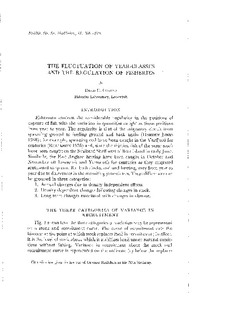| dc.contributor.author | Cushing, David H. | |
| dc.date.accessioned | 2009-01-08T12:04:49Z | |
| dc.date.issued | 1969 | |
| dc.identifier.uri | http://hdl.handle.net/11250/114512 | |
| dc.description.abstract | There are three sources of variation of recruitment; first that due to
random fluctuations alone, secondly that, due to variations in stock and
thirdly variations which are extreme at low and high levels of stock and
if these occur sequentially can cause catastrophic declines or sharp
increases in stock density. From a study of stock/recruitment curves of a
number of fish species, it appears that the curve for herring-like fishes
differs markedly from those, for example, of cod-like fishes or in more
general terms that the shape of the stock/recruitment curve is really a
function of its fecundity. That for the herring-like fishes is a near linear
curve whereas that for the cod-like fishes is markedly dome-shaped. It
follows that the herring-like fishes are very vulnerable to long-term
climatic changes and that the cod-like fishes are able to stabilize their
populations through long-term climatic changes merely because the
increased recruitment when stock is slightly reduced is very much greater
than that for the herring-like fishes. If stocks of fish are to be managed
then the stock/recruitment relatioilship has to be taken into account; a
form of self regenerating yield curve combining stock/recruitment and
yield-per-recruit was in fact put forward by BEVERTON and HOLT. A
development of such a curve is needed and one of the uses of such a curve
would he that management need not take too much notice of environmental
change, because if it occurred the stock would have been exploited
at its best rate before any environmental collapse took place. | |
| dc.format.extent | 575451 bytes | |
| dc.format.mimetype | application/pdf | |
| dc.language.iso | eng | en |
| dc.publisher | [Fiskeridirektoratets havforskningsinstitutt] | en |
| dc.relation.ispartofseries | Fiskeridirektoratets skrifter, Serie Havundersøkelser | en |
| dc.relation.ispartofseries | vol 15 no 3 | en |
| dc.title | The fluctuation of year-classes and the regulation of fisheries | en |
| dc.type | Research report | en |
| dc.source.pagenumber | s. 368-379 | en |
